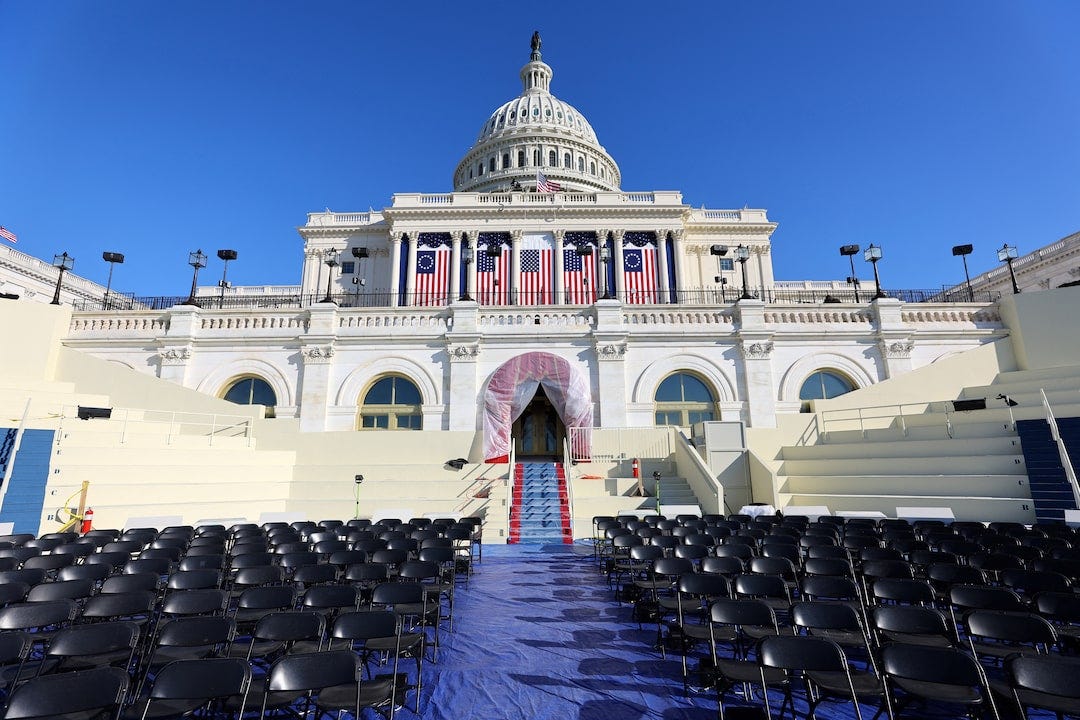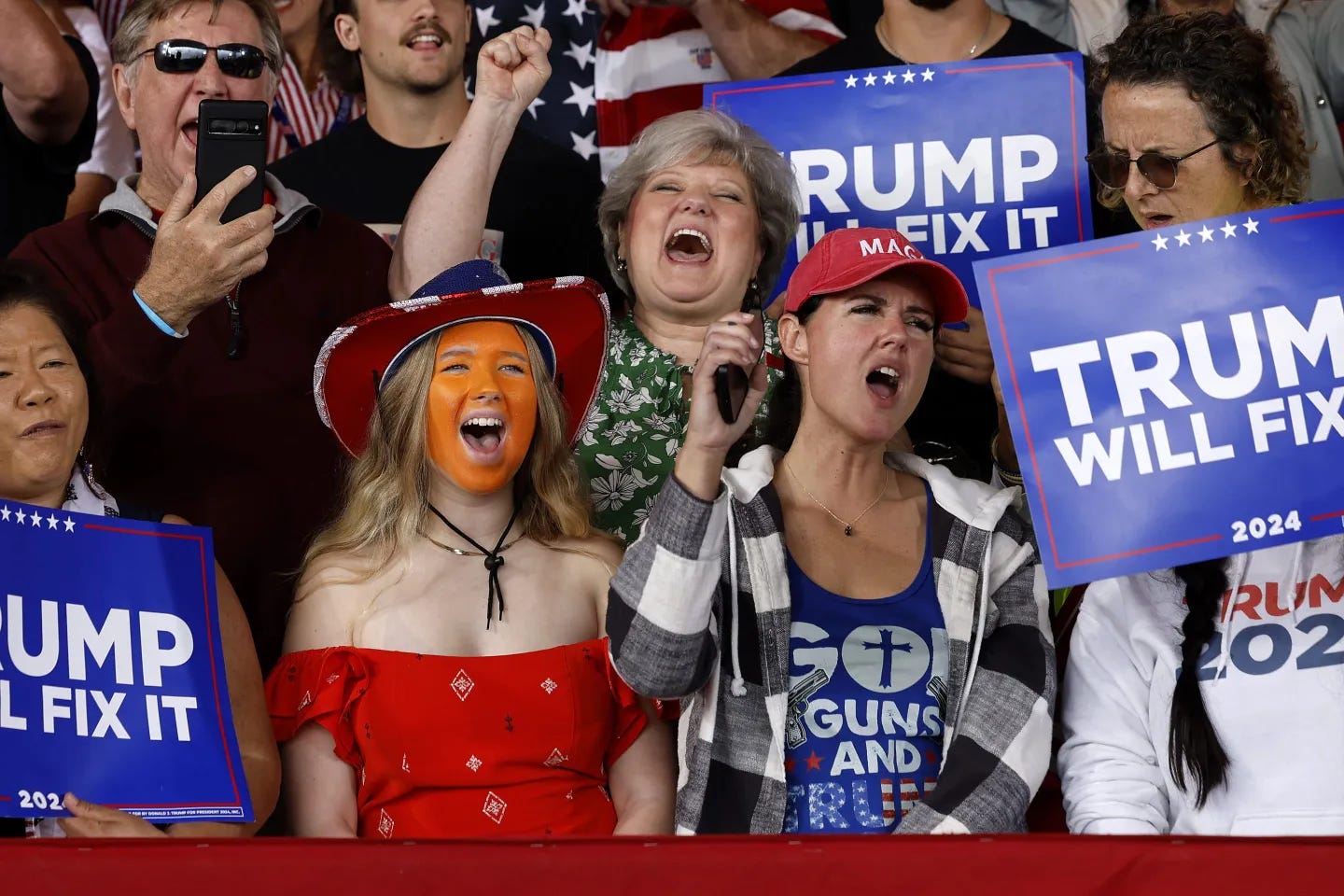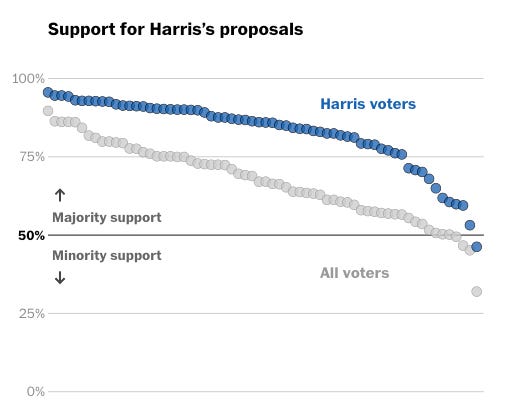America Doesn’t Want Donald Trump; They Just Don’t Know It Yet
The twice-impeached President-elect secured his second term in November, and there will be "hell to pay."

On November 5, 2025, Americans flocked to the polls to cast their verdict: a resounding electoral victory for the twice-impeached 45th President of the United States, convicted felon, adulterer, blasphemer, and real estate tycoon who has driven countless businesses into the ground, Donald John Trump. His voters—specifically, the non-MAGA loyalists—those who supported Trump for economic or religious reasons or simply because they believed he was the better candidate—were firm in their support. They vehemently reject the “uninformed voter” label. But was their vote for President indeed the well-informed decision they think it is? For the sake of argument, we’ll categorize Trump voters into a few groups.
Who voted for Trump?
We can discuss and debate demographics all day long. We can examine exit polling: who did he win, and who did he lose? But that’s been covered extensively. For our purposes, it’s more important to group people by their rationale for voting for Trump. Sometimes, you don’t know why someone voted for a particular candidate, but there are significant themes.
Okay, so what are the themes?
MAGA Loyalist
The MAGA loyalist is someone loyal to the “Make America Great Again” ideology. These people aren’t even necessarily lifelong Republicans or conservatives. They may have even voted for Obama back in the day. They tend to be very uneducated but think they know a lot due to spending hours being brainwashed by Fox News and Facebook. This voter is Trump’s favorite, the voter who would be by his side even if he “[stood] in the middle of Fifth Avenue and [shot] somebody.” Indicators that you’re dealing with this type of voter are:
Low information
Red hat (believe it or not, MAGA hats are highly uncommon among other groups of Trump voters)
Immigrant-hating (i.e., fully believes that immigrants commit more crimes than native-born American citizens and doesn’t understand the positive impact of immigrants on the American economy)
Strong January 6 apologist
Strong Access Hollywood tapes apologist
Pro-life but claims to be against government intervention in almost every other case.
Truly, in good faith, believes that public schools have an interest in forcing a sexual orientation upon their children that is not heterosexuality (even though, if anything, schools encourage heterosexuality)
Believes mainstream media lies to them
Little loyalty to the Republican Party
Uses the term “deep state” or “woke” a lot but cannot define either
Conservative Idealist
The Conservative Idealist is a lifelong Republican voter motivated by conservative ideology. This voter did not vote for Obama or Clinton. These voters support Trump’s policy positions, or at least those positions that they’ve been fooled into believing Trump holds. These voters are not staunch defenders of Donald Trump but forgive enough of his disqualifying behavior to qualify him to hold the nation’s highest office. Indicators of the Conservative Idealist are:
Often says that Trump doesn’t say the right thing, but he’s got the proper ideas.
Falls for Trump’s economic misrepresentations (i.e., they believe that Obama had a weak economy, which Trump turned around, and then Biden crashed when, in reality, the opposite occurred)
Republican Party loyalists
Often, religious and pro-life
Very often, they did not support Trump in the 2016 primary.
Will vote for J.D. Vance in 2028 (should he be the nominee)
The Elite Opp
The Elite Opp despises the so-called “elites,” and there’s nothing wrong with that. However, their hate can be misdirected. This voter doesn’t actually hate Elon Musk, the actual most “elite” individual on Earth! In this group lies some of the disenchanted left-leaning voters: the Obama and Clinton voters who now find themselves feeling abandoned by the Democratic Party. The Elite Opp is often:
Americentric (the belief that American culture is more important than others and that the world revolves around the United States)
Mistrusting elites and corporations while often simultaneously supporting some of the largest corporations if they indicate right-wing values.
Anti-immigration (due to the belief that immigrants take jobs from Americans)
Anti-woke, I feel like the government is enforcing political correctness.
Feel betrayed by both parties and mobilized to vote by Trump.
In favor of the destruction of all three-letter bureaucratic agencies, typically without nuanced consideration
It is important to note that, while I will categorize all Trump voters into these three groups for the purposes of argument, not all Trump voters perfectly fit this mold. Trump voters could fall into the MAGA Loyalist category yet only possess one or two indicators. I also am not saying that any of these categories is right or wrong, moral or immoral, or good or evil. These groups help us understand what to expect over the next four years: who will remain loyal, realize they were fooled, and behave differently in 2026 and 2028.
All these people voted for Trump for different reasons, so why will they all be let down?
Each voter will be let down for different reasons, but the groups will share everyday disappointments over the coming years. Remember 2016, when Trump promised seemingly 24/7 that he was going to build a huge wall on the United States-Mexico border and that Mexico would be paying for it (for some unknown reason)? Well, that didn’t happen at all, actually. Which voter group was most frustrated by that in the years following the 2016 election? Okay, yes, all of them. But specifically, the MAGA Loyalist. The MAGA Loyalist believes that Trump is infallible and that his word is The Word, so empty promises strike a chord. Unfortunately, those very same MAGA Loyalists are about to suffer a similar let-down. Trump’s strong promises of “MASS DEPORTATIONS NOW” (see below) are almost certain to be executed sub-par if any action is taken at all. This is not only because Trump is known for broken promises at a more extreme level than any politician in American history but also because of the likely incompetence of his administration. The incompetence of Trump and nearly all of the Cabinet members who would be tasked with such a complicated effort would act as the most “huge” barrier to success.
Make no mistake—broken promises are a guarantee, but that's not the point I'm trying to make. Trump voters and the American public are not going to be let down because Trump doesn't implement the policy that he campaigned on (although that must be expected), but because he does. The outrage that is bound to come will be because of the policies that Trump implements that he did say he planned to implement. It is no secret that the American voter base is among the most uninformed of any electorate in comparable countries (UK, Canada, etc.), so my argument is truly this: Americans don't want Donald Trump; they just don't know it yet.
The Data
Opinion has it's place, but with regards to whether the American public understands and supports Trump's (hardly existent) policy plan, opinion is moot. The information that we can gain from empirical data gathered from blind, controlled studies, is the most important metric. How much do the American people know about the policies that they voted for? More importantly, and the question that we're going to examine, would the American people support Harris' or Trump's policies if they did not know which candidate supported which policies?
The answer is clear: voters unknowingly back almost every single one of Harris’ policy positions. As seen in the graphs above, most registered voters supported roughly 46 of the 50 policies presented. However, only about half of Trump’s policies were supported by most registered voters. This data alone is enough to say that, yes, the American people made a mistake at the ballot box last November. They simply lacked a complete understanding of candidate policy positions.
YouGov split the data into multiple categories by policy area: crime, education, economy, immigration, social and reproductive issues, environment, health, and foreign policy. In every single category except “economy,” the most popular policy belonged to Kamala Harris. However, even on economic policy, all eight of Harris’ policy positions were supported by the majority, but only six of Trump’s eight faired as well. Also, in every single category, with no exceptions, all but one or less of Harris’ policies were supported by the majority. Again, true in all categories, most of Harris’ policies were supported by the majority.
What about Trump? Well, his positions did not resonate with voters either. On crime, a position that Americans consistently polled as trusting Trump more greatly, only one of Trump’s policies was supported by the majority, contrasted with the other six policies supported by less than half of the country. On education, Trump polled favorably on only two of his eight positions. Even on the economy and immigration, two issues that likely won Trump the White House, he faired poorly (or at least worse than Harris). On the economy, six of his eight policies were supported by most of the country, compared to all eight of Harris’ policies. On immigration, again, six of Trump’s eight policies received the majority support, compared to seven of Harris’s. Harris performed similarly stronger on each issue at hand.
There is no question that Americans very strongly prefer Harris’ policies to Trump’s, but unfortunately for the country, we didn’t recognize that. Why is this bound to be a problem? Timothy Snyder encapsulates it perfectly in his 2017 book, On Tyranny: Twenty Lessons from the Twentieth Century:
“We believe that we have checks and balances, but have rarely faced a situation like the present: when the less popular of the two parties controls every lever of power at the federal level, as well as the majority of statehouses. The party that exercises such control proposes few policies that are popular with the society at large, and several that are generally unpopular—and thus must either face democracy or weaken it.”
The aforementioned “less popular of the two parties” is indisputably the MAGA Republican Party.
Yes, before I mentioned that the American voter base is historically (and obviously, presently) uninformed. I mean this not as an insult to any individual voter but to the general state of the American electorate. However, it is important to give credit where credit is due. Harris voters knew her policies well and voted accordingly:
But as we learned earlier, it’s not much of a surprise that Harris voters majorly supported every single policy of hers except one, given that the entire American electorate also did.
Where does this leave us?
It leaves us to wait anxiously. Donald Trump will be the 47th President of the United States tomorrow. As proved above, the American people made their mistake, which cannot be undone. Sparing any successful impeachments or unexpected resignation, Donald Trump will be the President from January 20, 2025, through January 19, 2029, and will enact his unpopular policy. Very rarely does an incompetent administration breaking promises help the country, but it’s what we must hope for from Trump 2.
It is difficult to remain optimistic, and we hope we didn’t give the impression that we are optimistic. We are not. The Better Press is run by patriots. In a perfect world, TBP will publish an article on January 19, 2029, chronicling an incredibly successful Trump presidency. A presidency that drove the American economy further through the roof, successfully handled immigration in a manner that prioritizes both national security and humanitarianism, stopped foreign conflicts and injustices, found a way to correct the Orwell-esque collapse of social media and free speech, told the truth, and did not praise dictators and their evil, authoritarian regimes. Is this in any way likely? It’s probably safe to say no.







